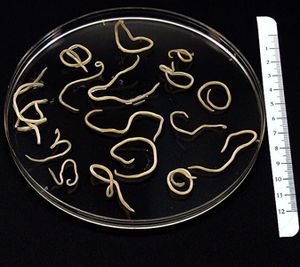Baylisascaris procyonis and Associated Diseases
Introduction and Phylogeny

By Nadia Torok
Baylisascaris procyonis is a parasitic nematode, or helminth, endemic to raccoon (Procyon lotor) [1] populations[2]. This parasite causes baylisascariass in humans upon infection[2] and can infect other small mammals as well[1]. The species is distinguished from other helminthes by its invasion of the central nervous system (CNS) in hosts, as well as the continued growth of larvae within the CNS to a large size[2]. The first documented cases occurred in two young boys in 1984 and 1985[2].
This parasite is responsible for various diseases in humans and other animals, which can be serious and often fatal in humans despite treatment[2]. Though infection with B. procyonis is rare and there have been fewer than 25 human cases reported in the United States[3], infection is thought to be frequently misdiagnosed [3] and prognosis is very poor[2]. The major clinical manifestations of B. procyonis include visceral larva migrans, neural larva migrans, and ocular larva migrans, which fall under the broader description of infection with B. procyonis, termed Baylisascaris[2].
Baylisascaris procyonis is a member of large nematodes in the order ascaridida, related to species such as Ascaris lumbricoides, Toxocara canis, and Toxocara cati, which are more commonly observed parasites affecting humans, dogs, or cats[2]. Originally, B. procyonis was classified as Ascaris columnaris in 1931, and it is closely related to B. columnaris and B. melis, other worms that parasitize skunks and badgers[2].
These roundworms are tan in color and display sexual dimorphism, as females range in size from 20-22 cm and males from 9-11 cm [2], making them some of the larger parasitic nematodes[2]. Females lay 115,000 to 179,000 eggs per day[2]. Eggs are an ellipsoidal shape, dark brown, and 63-88 μm by 50-70 μm in size [2]. It is estimated that raccoons shed up to 20,000 eggs per gram of feces[1], while only 5,000 eggs or fewer is sufficient to infect a human [4]. An image of adult B. procyonis obtained from a raccoon can be seen at the right.
The insertion code consists of:
Double brackets: [[
Filename: PHIL_1181_lores.jpg
Thumbnail status: |thumb|
Pixel size: |300px|
Placement on page: |right|
Legend/credit: Electron micrograph of the Ebola Zaire virus. This was the first photo ever taken of the virus, on 10/13/1976. By Dr. F.A. Murphy, now at U.C. Davis, then at the CDC.
Closed double brackets: ]]
Other examples:
Bold
Italic
Subscript: H2O
Superscript: Fe3+
Introduce the topic of your paper. What is your research question? What experiments have addressed your question? Applications for medicine and/or environment?
Sample citations: [5]
[6]
A citation code consists of a hyperlinked reference within "ref" begin and end codes.
Latrine habits: [1] This is a test, according to a source.[1]
Section 1
Include some current research, with at least one figure showing data.
Every point of information REQUIRES CITATION using the citation tool shown above.
Section 2
Include some current research, with at least one figure showing data.
Section 3
Include some current research, with at least one figure showing data.
Section 4
Conclusion
References
- ↑ 1.0 1.1 1.2 1.3 1.4 Page, K.L., Swihart, R.K., and Kazacos, K.R. "Raccoon Latrine Structure and Its Potential Role in Transmission of Baylisascaris procyonis to vertebrates." 1998. The American Midland Naturalist 140(1):180-185.
- ↑ 2.00 2.01 2.02 2.03 2.04 2.05 2.06 2.07 2.08 2.09 2.10 2.11 2.12 [[1] Gavin, P.J., Kazacos, K.R., and Shulman, S.T. "Baylisascariasis." 2005. Clinical Microbiology Reviews 18(4): 703-718. DOI: 10.1128/CMR.18.4.703-718.2005]
- ↑ 3.0 3.1 [[2] "Parasites - Baylisascaris Infection." 2012. Centers for Disease Control Global Health - Division of Parasitic Diseases.]
- ↑ [[3] Southern Nevada Health District. "Fact Sheet: Raccoon Roundworm (Baylisascaris procyonis)." 2007. Southern Nevada Health District, Office of Epidemiology.]
- ↑ Hodgkin, J. and Partridge, F.A. "Caenorhabditis elegans meets microsporidia: the nematode killers from Paris." 2008. PLoS Biology 6:2634-2637.
- ↑ Bartlett et al.: Oncolytic viruses as therapeutic cancer vaccines. Molecular Cancer 2013 12:103.
Authored for BIOL 238 Microbiology, taught by Joan Slonczewski, 2017, Kenyon College.
